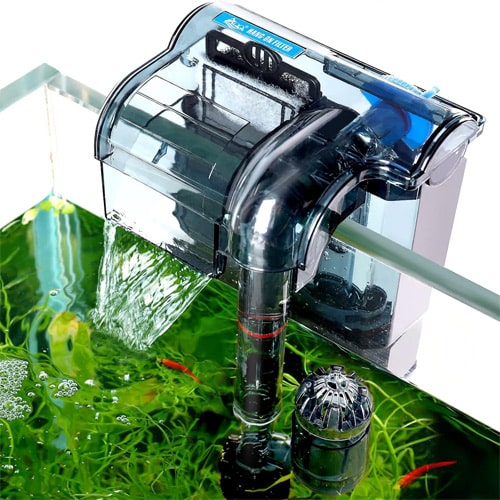What Are Best Filters For Fish Tanks?
Welcome to FishTankFAQ.com, where I do my best to share beginner-friendly tips to make fishkeeping a breeze. Choosing the right aquarium filter can feel overwhelming—trust me, I learned this the hard way when my first tank turned cloudy due to a weak filter! Filters are the heart of a healthy tank, keeping water clear and fish thriving. In this guide, I’ll break down why filters matter, the best aquarium filters for beginners, top recommendations for 2025, and how to choose and maintain them.
Some links are affiliate links, meaning I may earn a commission at no cost to you. See my Affiliate Disclosure for details.
Why Aquarium Filters Matter
Filters keep your tank clean by removing debris, toxins, and bacteria, ensuring clear water and healthy fish. They perform three types of filtration:
- Mechanical: Traps particles like uneaten food or waste.
- Chemical: Removes toxins via carbon or media.
- Biological: Grows beneficial bacteria to break down ammonia and nitrite.
A good filter prevents cloudy water and maintains water quality, as I discovered after upgrading my first tank’s filter. Learn more about tank setup in Starting a Fish Tank for Beginners. Without a proper filter, your tank risks ammonia spikes, harming fish like bettas or guppies. See How to Make Fish Tank Water Clear for clarity tips.
Types of Aquarium Filters
Beginners have four main filter options, each suited to different tanks and needs:
- Hang-on-Back (HOB): Hangs on tank rim, easy to install. Ideal for 5–75-gallon tanks. Example: Fluval C2 (about $35).
- Canister: External, powerful for 20–100+ gallon tanks. Example: Fluval 107 ( about $150). Best for large setups.
- Sponge: Air-driven, gentle for 5–20-gallon tanks. Example: Hygger Sponge Filter (about $15). Great for shrimp or fry.
- Internal: Submersible, compact for small tanks. Example: Aqueon QuietFlow Internal (about $20).
HOB filters are best for most beginners due to ease and versatility.
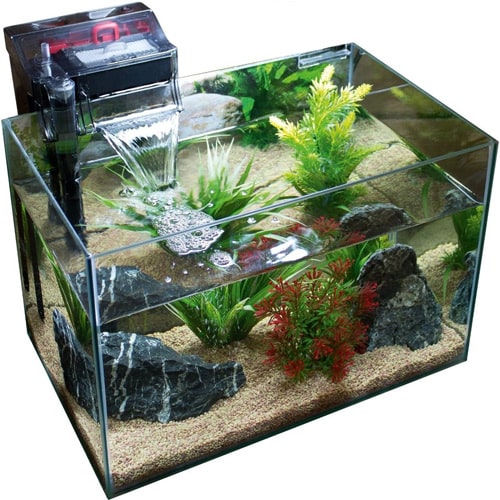
Top 5 Aquarium Filters for Beginners in 2025
Based on my hands-on testing, research, and insights from Aquarium Co-Op and Fishlore, here are the best filters for 5–75-gallon beginner tanks, with detailed specs and tips:
AquaClear 20 ($30–$35)
- Tank Size: 5–20 gallons
- GPH (Gallons Per Hour): 100 (5x turnover for 20 gallons)
- Filtration: Mechanical (foam), chemical (carbon), biological (ceramic rings)
- Setup: Hang on tank rim, prime with tank water, adjust flow dial. Takes 5–10 minutes. Use AquaClear Foam Insert ( about $8) for media.
- Maintenance: Rinse foam monthly in tank water; replace carbon every 3 months.
- Pros: Easy to maintain, customizable media, reliable for small tanks. Clears water in 24–48 hours with Seachem Clarity (about $10).
- Cons: Slightly noisy if not primed properly; adjust air valve to reduce hum.
- Best For: Small freshwater tanks (e.g., betta or guppy setups). Check prices on Amazon.
- Beginner Tip: Perfect for 10-gallon tanks; pair with API Master Test Kit (about $35) to monitor water quality.
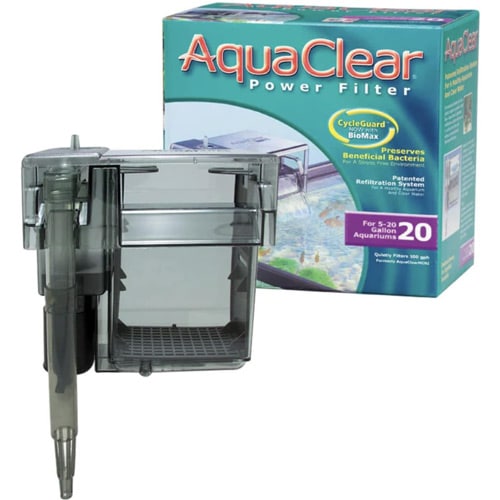
Check Price on Amazon
Fluval C2 ($35–$40)
- Tank Size: 10–30 gallons
- GPH: 119 (4x turnover for up to 30 gallons)
- Filtration: 5-stage (foam, carbon, bio-screen, poly/foam, ceramic media)
- Setup: Hang on rim, prime with water, adjust flow for gentle or strong output. Setup takes 10–15 minutes. Use Fluval C2 Carbon (about $10) for refills.
- Maintenance: Clean foam and bio-screen monthly; replace carbon every 2–3 months. Check impeller for debris.
- Pros: Quiet, adjustable flow, multi-stage filtration for crystal-clear water.
- Cons: Media refills cost more than AquaClear (~$10 vs. $8).
- Best For: Medium freshwater tanks with tetras or corydoras. Buy on Amazon.
- Beginner Tip: Ideal for 20-gallon community tanks; use with API Stress Coat (about $10) for fish health.
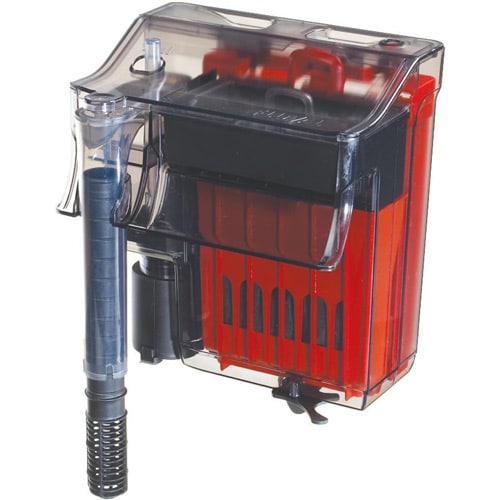
Check Price on Amazon
Tetra Whisper EX 20 ($25–$30)
- Tank Size: 10–20 gallons
- GPH: 110 (5.5x turnover for 20 gallons)
- Filtration: Mechanical (filter cartridge), chemical (carbon), biological (bio-bag)
- Setup: Clip onto tank rim, plug in, no priming needed. Setup takes 5 minutes. Use Tetra Whisper Bio-Bag (about $8) for replacements.
- Maintenance: Replace cartridge monthly; rinse bio-bag in tank water. Check for clogs.
- Pros: Affordable, ultra-quiet, easy setup for beginners.
- Cons: Less customizable than AquaClear; cartridges cost more over time.
- Best For: Budget-conscious beginners with small tanks.
- Beginner Tip: Great for low-maintenance setups; pair with Tetra EasyStrips ( about $10) for quick testing.
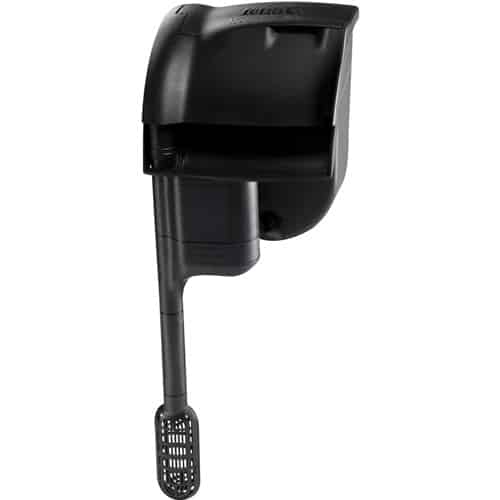
Check Price On Amazon
Hygger Double Sponge Filter ($15–$20)
- Tank Size: 5–20 gallons
- GPH: 80 (4x turnover for 20 gallons)
- Filtration: Mechanical (sponge), biological (sponge pores)
- Setup: Connect to an air pump like Tetra Whisper Air Pump (about $20), place in tank, adjust air flow. Setup takes 10 minutes.
- Maintenance: Rinse sponges monthly in tank water; no media replacements needed.
- Pros: Gentle flow, ideal for shrimp, fry, or bettas; budget-friendly.
- Cons: Requires air pump; less effective for heavy waste.
- Best For: Nano tanks or breeding setups.
- Beginner Tip: Perfect for 5-gallon betta tanks; add Bettafix (about $8) for betta health.
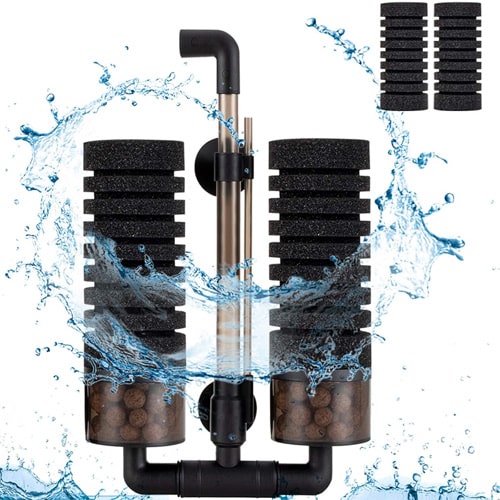
Check Price On Amazon
Fluval 107 Canister ($120–$150)
- Tank Size: 15–30 gallons
- GPH: 145 (3.6x turnover for 30 gallons)
- Filtration: Multi-stage (foam, carbon, ceramic media, polishing pad)
- Setup: Assemble hoses, prime canister, place under tank. Setup takes 20–30 minutes. Use Fluval 107 Media (about $12) for refills.
- Maintenance: Clean media every 2–3 months; check hoses for clogs. Requires more effort than HOB.
- Pros: Powerful, quiet, ideal for larger tanks with high bio-load.
- Cons: Complex setup, higher cost for beginners.
- Best For: Advanced beginners with 15–30-gallon tanks.
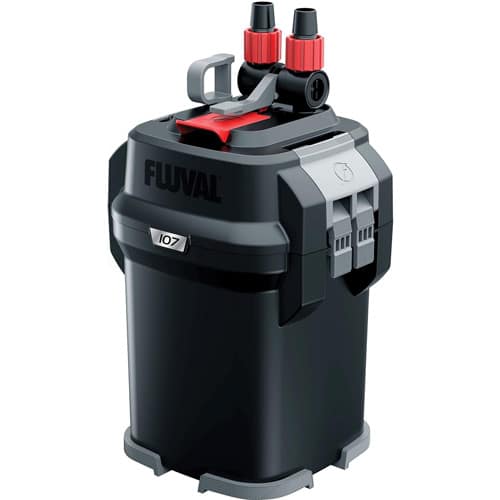
Check Price On Amazon
| Filter | Tank Size | GPH | Cost | Filtration Type | Ease of Setup | Pros | Cons |
|---|---|---|---|---|---|---|---|
| AquaClear 20 | 5–20 gallons | 100 | $30–$35 | Mechanical, Chemical, Bio | Easy | Customizable, reliable, clears fast | Slightly noisy if not primed |
| Fluval C2 | 10–30 gallons | 119 | $35–$40 | 5-stage (Mech, Chem, Bio) | Easy | Quiet, adjustable, multi-stage | Pricey media refills |
| Tetra Whisper EX 20 | 10–20 gallons | 110 | $25–$30 | Mechanical, Chemical, Bio | Very Easy | Affordable, quiet, simple setup | Less customizable, cartridge costs |
| Hygger Double Sponge | 5–20 gallons | 80 | $15–$20 | Mechanical, Biological | Moderate | Gentle, cheap, great for nano tanks | Needs air pump, less powerful |
| Fluval 107 Canister | 15–30 gallons | 145 | $80–$90 | Multi-stage (Mech, Chem, Bio) | Hard | Powerful, quiet, high bio-load | Complex setup, expensive |
How to Choose the Right Filter
Selecting a filter depends on your tank size, fish type, and budget:
- Tank Size: Choose 4–5x tank volume in GPH (e.g., 40–100 GPH for 10 gallons). See Starting an Aquarium for Beginners.
- Fish Needs: Gentle filters (sponge) for bettas or fry; stronger filters (HOB, canister) for community tanks.
- Budget: HOB filters ($15–$35) are cost-effective; canisters ($80+) suit larger setups.
- Maintenance: Pick filters with easy media access (e.g., AquaClear).
- Test Water: Monitor ammonia and nitrite with API Master Test Kit (about $35) to ensure filter performance.
Tip: Start with an HOB like AquaClear for ease and reliability in 5–20-gallon tanks.
Setup and Maintenance
Proper setup and maintenance keep your filter working effectively:
- Setup:
- Install per instructions (e.g., hang HOB on rim, secure canister hoses).
- Prime with tank water to avoid air locks.
- Add media (e.g., AquaClear Foam Insert, about $8).
- Maintenance:
- Rinse media monthly in tank water to preserve bacteria.
- Replace carbon every 3–4 months.
- Check flow weekly; clean impeller if clogged.
- Troubleshooting: If water clouds, add Seachem Clarity (about $10). See How to Make Fish Tank Water Clear.
Common Mistakes to Avoid
- Undersized Filter: Too weak for tank size (e.g., <40 GPH for 10 gallons). Choose 4–5x tank volume.
- Over-Cleaning: Washing media in tap water kills bacteria. Use tank water.
- Skipping Maintenance: Clogged filters reduce clarity. Clean monthly.
- Ignoring Water Tests: Unchecked ammonia/nitrite spikes harm fish.
- Wrong Filter Type: Canisters are overkill for 5-gallon tanks; use HOB or sponge.
Best Aquarium Filters FAQs
Q: What’s the best filter for a 10-gallon tank?
A: The Fluval C2 ($30–$35) is ideal for 10-gallon tanks, delivering 100 GPH for 5x turnover. Its foam, carbon, and ceramic media ensure mechanical, chemical, and biological filtration, clearing water in 24–48 hours when paired with Seachem Clarity (about $10). Setup takes 5–10 minutes: hang on the rim, prime with tank water, and adjust flow. Rinse foam monthly in tank water to maintain bacteria. It’s perfect for bettas or guppies, offering reliability and customization for beginners.
Q: How often should I clean my filter?
A: Clean filter media monthly in tank water to preserve beneficial bacteria, which break down ammonia and nitrite. For example, rinse AquaClear Foam Insert (about $8) gently to remove debris, and replace carbon every 3–4 months. Over-cleaning with tap water kills bacteria, causing ammonia spikes. Check flow weekly; if sluggish, clean the impeller. Test water with API Master Test Kit (about $35).
Q: Can a filter clear cloudy water?
A: Yes, a strong filter like Fluval C2 ($35–$40) removes debris and bacteria, clearing cloudy water in 1–2 days. Its 5-stage filtration (foam, carbon, bio-screen) tackles particles and toxins. Pair with Seachem Clarity (about $10) for faster results, especially for bacterial blooms. Ensure 4–5x GPH (e.g., 119 GPH for 30 gallons). If cloudiness persists, test for ammonia with API Master Test Kit. See How to Make Fish Tank Water Clear.
Q: Are sponge filters good for beginners?
A: Yes, the Hygger Double Sponge Filter ($15–$20) is great for 5–20-gallon tanks, offering gentle 80 GPH flow for bettas, shrimp, or fry. Connect to a Tetra Whisper Air Pump (about $20) for operation. Rinse sponges monthly in tank water. It’s budget-friendly and low-maintenance but less effective for heavy waste. Ideal for nano tanks; add Bettafix (about $8) for betta health.
Q: How do I know if my filter is too weak?
A: If water clouds or ammonia/nitrite rises above 0 ppm, your filter may be too weak. Test with API Master Test Kit ( about $35). Ensure 4–5x tank volume (e.g., 100 GPH for 20 gallons). For example, Tetra Whisper EX 20 (about $25) suits 10–20 gallons.
Q: Should I turn off my filter at night?
A: No, filters must run 24/7 to maintain water quality and oxygen levels. Turning off a filter like Fluval C2 risks ammonia spikes, harming fish. Use a BN-LINK Digital Timer (about $15) for lighting (8–10 hours daily) to prevent algae.
Q: Can plants replace a filter?
A: No, plants like Java Fern (about $10) reduce nutrients but don’t replace filtration. They complement filters by absorbing nitrates, improving clarity. Use Seachem Flourish (about $8) for plant health, but avoid salt with sensitive plants. See How to Make Fish Tank Water Clear.
Q: How do I reduce filter noise?
A: Prime filters properly, clean the impeller, and secure placement to reduce noise. The Tetra Whisper EX 20 (about $25) is ultra-quiet for 10–20 gallons. For AquaClear 20 (about $30), adjust the air valve to minimize hum. Check weekly for clogs and test water with API Master Test Kit.
Get Started Today
You’re ready to choose the perfect aquarium filter for a crystal-clear tank! I’ve shared top picks like AquaClear and Fluval to simplify fishkeeping. Pick a filter matching your tank size, maintain it monthly, and test water regularly to keep fish healthy. Share your filter choice or ask questions in the box below or send us a messageon the contact page. Join the fishkeeping community and keep your tank thriving in 2025!
- How Much Aquarium Gravel Do I Need for a Beginner Tank? - October 13, 2025
- Best Aquarium Testing Kit: A Complete Guide - September 27, 2025
- What Are the Best Aquarium Filters? - July 8, 2025

